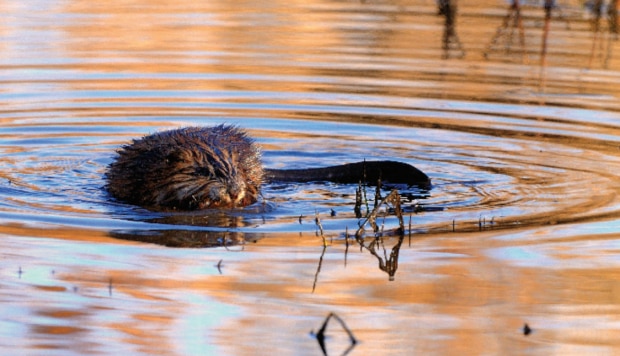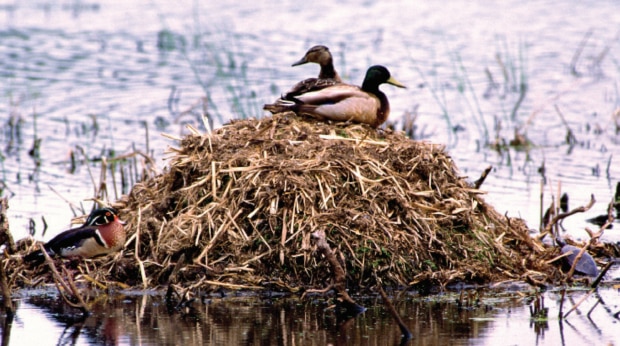- Division of Fisheries and Wildlife
Media Contact
Media Contact, MassWildlife
Muskrats are common in Massachusetts and can be found in most lakes, ponds, open swamps, marshes (including salt marshes), and slow-moving sections of rivers and lowland streams. But, unless you take the time to look for them, you could probably go a lifetime without ever knowing that muskrats exist! Take a moment to get acquainted with these furry marsh-dwelling mammals.
Description
Contrary to their name (and despite their naked tails), muskrats aren’t actually rats. Muskrats are rodents, but are more closely related to voles than to true rats.
Muskrats are about 5 inches tall and 10–14 inches long and only weigh about 2–3 pounds. They have sharp claws on both their front and back feet used primarily for digging. The muskrat’s reddish to dark brown or black fur coat is warm, soft, and dense. It is composed of long, glossy guard hairs that overlay a much denser layer of underfur that traps air and provides insulation and buoyancy while swimming.
Their distinctive 8–10-inch hairless tail is flattened vertically and provides balance on land and steering while swimming. Because the tail tends to drag when the animal is on land, a muskrat track is distinctive and easy to identify in mud, slush, or snow.Like beavers, muskrats slap their tails when alarmed before diving under water.
Aquatic adaptations
Like many other aquatic mammals, the muskrat’s ears and nostrils close automatically when under water. And like the beaver, the muskrat has a lip structure that allows it to bite and chew while submerged without getting a mouthful of water. The physiology of muskrats and many other aquatic mammals enable them to be less sensitive to the buildup of carbon dioxide in their blood. This allows them to remain submerged for 15 minutes or more. Muskrats also possess a circulatory adaptation called regional heterothermia that reduces heat loss from the feet and tail while still protecting those extremities from frostbite.
Home sweet home
Muskrats are highly adaptable and capable of thriving in a wide range of climates and wetland habitats. If there are wetlands near your home, or if your commute takes you past any wetlands, you are somewhere in the vicinity of muskrats on a daily basis.
Muskrats make their homes by tunneling into banks. Burrows, which can be quite elaborate and reach up to 45 feet in length, may be used for many generations. Burrow openings start underwater then rise above the water table and open into multiple chambers.
Marsh-dwelling muskrats that have no banks to burrow into construct their own houses that rise like mounds from the marsh. These are often built on submerged stumps or similar sturdy foundations. Muskrats pile mud and vegetation roughly 4–6 feet in diameter and 2–3 feet above the water’s surface. As the pile settles, the muskrat tunnels into it and eventually creates a hollowed area with one or two chambers. In addition to providing shelter, these houses offer an added benefit of being edible if food supplies become limited during the winter.
Life history
Basic muskrat social structure consists of a monogamous pair of adults and their young of the year. The pair mark the borders of their territory with musk and conspicuous piles of droppings, and they defend it vigorously from other muskrats that are not part of the immediate family.
Breeding season begins in late March or April. Depending on habitat quality and population density, females give birth to 1–3 litters of 5–10 young from late spring into early fall. The responsibility of rearing the young falls entirely to the female. The babies are weaned in less than a month and typically remain within their mother’s territory until the following spring.
Muskrats are omnivores feeding mostly on a wide variety of succulent aquatic and terrestrial vegetation. They also eat freshwater mussels, snails, crayfish, frogs, and insects. The muskrat’s predators include mink, raccoons, coyotes, and foxes. The typical lifespan of an adult in the wild is about 3–4 years.
If you’d like to try to observe a muskrat, grab a pair of binoculars and head to a nearby wetland area. Look along dirt banks or on raised mounds of mud and vegetation. Muskrats are most active around dawn and dusk but are known to enjoy feeding in sun on calm fall and winter afternoons. Don't forget to check muddy or snowy areas for muskrat tracks. Click here to see the tracks of muskrats and other common Massachusetts animals.


